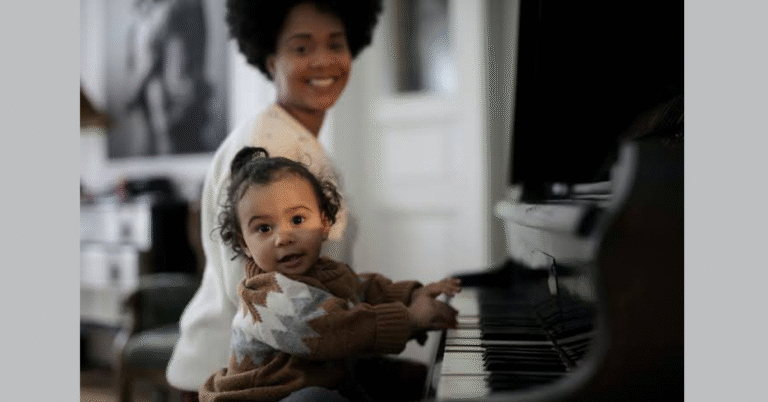Autism Spectrum Disorder (ASD) presents unique challenges and remarkable abilities in children. All the same, while therapies and support strategies vary, one approach is gaining widespread attention and a warm approval from parents and professionals alike—music therapy. Let’s explore how parents can use music therapy for autism to build communication, reduce anxiety, and help their children thrive.

What is Music Therapy?
A Definition for Parents
Music therapy is a clinically proven practice that uses music to address physical, emotional, cognitive, and social needs of individuals. For children with autism, music therapy isn’t just about singing or playing instruments. Indeed, it’s a therapeutic intervention that helps them express themselves, develop language, improve coordination, and connect with others.
Why Music?
Interestingly, music bypasses the brain’s language centers and engages multiple areas at once. Furthermore, children with autism often respond more positively to rhythm, melody, and sound than to verbal instructions or social cues. Certainly, this makes music therapy an ideal method to build communication pathways and reduce behavioral challenges.

How Music Therapy Helps Children with Autism
- Enhances Communication Skills
Many autistic children struggle with speech, body language, and facial expressions. In this case, music therapy can encourage non-verbal and verbal communication through songs, call-and-response exercises, and vocal play. Moreover, parents can try singing familiar nursery rhymes and pausing before the last word, encouraging your child to fill it in.
Why it works: Music gives predictable patterns, making it easier for children to anticipate, repeat, and communicate.
- Reduces Anxiety and Meltdowns
Routine changes or sensory overloads can cause meltdowns. However, music can be a calming anchor during stressful moments.
Parents can try: Playing soft instrumental music during transitions (e.g., before bedtime or a doctor’s visit).
Why it works: Slow rhythms and predictable melodies can lower the heart rate and soothe the nervous system.
- Improves Social Interaction
Interestingly, through musical play, children learn turn-taking, eye contact, listening, and cooperative engagement.
Parents can try: Use simple instruments like drums or tambourines to take turns making sounds.
Why it works: Interactive music builds social cues in a non-threatening, enjoyable setting.
- Boosts Emotional Expression
Many autistic children struggle to express how they feel. However, music helps them explore and release emotions without needing words.
Parents can try: Encourage your child to create a “happy,” “sad,” or “angry” song with toy instruments.
Why it works: Music gives form to feelings, helping children process and communicates safely.

Getting Started with Music Therapy at Home
- Observe Your Child’s Response to Music
Before diving in, spend a week watching how your child reacts to different types of music. Do they calm down with classical music? Get excited with drum beats? Prefer singing to listening?
Tip: Keep a notebook to track their responses to genres, instruments, and volume levels. Thus, it can really be an exciting journey to learn about your child’s behavioral pattern.
- Create a Music-Friendly Environment
Set up a safe, sensory-friendly music corner in your home. In particular, include soft cushions, headphones, musical toys, calming visuals and musical instruments. Avoid loud or overly complex sounds unless your child enjoys them. Similarly, you can engage a music tutor for your kids. This in particular is a sure way to get them in the right mood.
- Establish Musical Routines
Autistic children often thrive on routines. Integrate music into your daily schedule.
Morning music: A cheerful wake-up song.
Activity music: A special tune to signal playtime or clean-up.
Wind-down music: Soft lullabies or ambient soundscapes before sleep.
- Use Songs with Predictable Structure
Simple, repetitive songs are easier for autistic children to learn and sing along to. Use songs that repeat phrases and have clear choruses. Create personal songs that include your child’s name and favorite things.
Working with a Certified Music Therapist
While at-home methods are effective, a certified music therapist can provide tailored interventions based on your child’s unique needs.
What to Expect from a Professional Session:
A professional will provide Individual assessments of your child’s sensory and communication needs. In addition, he or she will recommend goal-oriented activities using rhythm, melody, instruments, and movement. Furthermore, the therapist will track progress over time with adaptations as your child grows.
How to Find One
Below are some common Instruments Used in Autism Music Therapy. Indeed, parents can safely incorporate some instruments into home routines:
- Drums and Percussion:
Good for motor skills and rhythm training.
Easy for non-verbal children to express energy.
- Xylophones and Keyboards:
Help with auditory recognition and fine motor control.
Can be used to play basic melodies and encourage creativity.
- Shakers and Bells:
Lightweight and accessible for sensory stimulation.
Fun to use in musical games and song cues.
Music Therapy Activities for Parents and Kids
- Name That Emotion
Play different types of music (happy, sad, excited, calm).
Ask your child to draw a face or pick a color that matches the feeling.
- Sound Imitation Games
Use claps, drum taps, or vocal sounds.
Take turns copying each other’s rhythms or pitches.
- Story Songs
Make up songs that describe daily routines or social stories (e.g., brushing teeth, visiting grandma).
Use visuals or puppets to enhance the fun.
Tips for Parents New to Music Therapy
- Patience is Key
Every child reacts differently to music. Some may engage immediately, while others might need more time to feel comfortable.
- Follow Your Child’s Lead
Let your child explore the sounds they enjoy most. The goal is to build a positive, joyful connection with music.
- Keep Sessions Short and Sweet
Five to ten minutes is often enough for young children, especially those with sensory sensitivities.
- Celebrate Small Wins
Did your child hum along today? Tap in rhythm? Make eye contact during a song? That’s progress!
Final Thoughts: Empowering Parents Through Music
Music therapy for autism isn’t just for clinics or professionals—it starts in the living room, in the car, at bedtime. As a parent, you have the unique opportunity to bring healing, connection, and expression into your child’s life through music.
In summary, music can become a powerful part of your family’s journey. Whether you’re humming lullabies or partnering with a trained therapist, music therapy is very impactful. Moreover, in the rhythm of those moments—note by note—you’ll discover breakthroughs that words alone could never reach.




